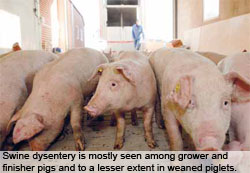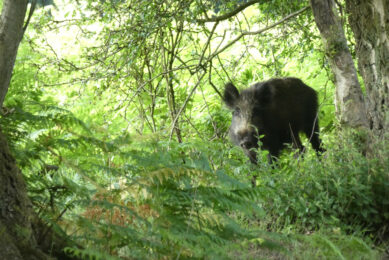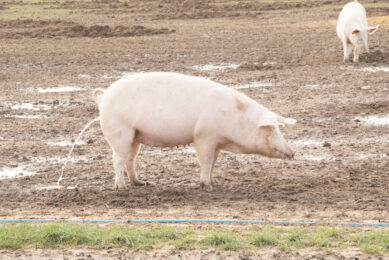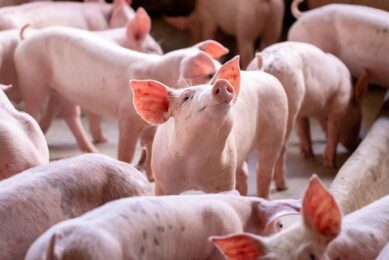Dysentery: Prevention rather than cure

Swine dysentery or bloody diarrhoea is a bacterial intestinal disease with varying clinical pictures caused by the anaerobic spirochete Brachyspira hyodysenteriae. Since the ban on antimicrobial growth promoters in the EU, swine dysentery has become an emerging problem in pig farming. Severe economical losses, associated with this disease, and the bacteria’s widespread resistance to antibiotics increases the need for good prevention.
By Ir Ellen Van Meenen, product manager functional feed ingredients and Katrien De Smet, veterinarian, product developer, Vitamex, Belgium
Brachyspira hyodysenteriae can enter farms in three ways. Primarily swine dysentery is transferred through contact with infected pigs which can excrete the pathogen up to 90 days after the symptoms. Contamination of a farm via supply of infected piglets or breeding animals is unfortunately very common. Manure is a second source of contamination. Since Brachyspira is oxygen tolerant, it can remain alive for up to two months in the manure. Through vehicles, clothing, shoes and equipment, manure can be a constant source of (re)contamination. Finally, also rodents constitute a reservoir of Brachyspira.
In mice, the excretion period can amount to six months and more. Rats having an excretion period of only two days can however also be important vectors because of their moving lifestyle. Other animals such as dogs, birds and insects can also serve as vectors for the transfer and spreading of the disease.
Disease course
Animals are infected after an oral intake of Brachyspira pathogens from a contaminated environment or infected vectors. The incubation period amounts to an average of ten to 14 days, but can vary from two days to two months depending on the strain and infection dose, stress situations (e.g. transport), present medication and immunity. The age of the pig and stability of the intestinal flora also have an impact.
The infection is mainly located in the colon. Several virulence factors are described for B. hyodysenteriae. The germ is quite agile, so it can move active through the mucus layer down to the intestinal mucous membrane. In addition, the pathogen is able to produce two toxins: a hemolysin which is cytotoxic and is responsible for damaging the intestinal wall and a lipo-oligosaccharide that possesses endotoxin activity. In the event of infection, the mucous membrane of the large intestine is damaged, resulting in a big loss of (water) absorbing capacity.
Symptoms
Swine dysentery is a contagious diarrhoea which affects mainly the large intestine. Animals suffering from the disease have a severe diarrhoea, often bloodstained and mucoid. Also sudden death sometimes occurs in heavy finisher pigs. In milder cases, the faeces are soft, yellow to grey-brown and cement-like in a further stage. The associated symptoms of this diarrhoea are hollowed flanks, fecal staining of the perineum, dehydration, loss of body condition and gaunt appearance. On a long term, because of the chronic affected colon, pigs will show a continuous depression of growth and an increase in feed conversion.
The characterising aspect of bloody and slimy faeces is often not seen. Because of this sometimes discrete image of the symptoms often swine dysentery as such is not noticed on the farm. Only when the bacterium is widespread within the farm, resulting in a higher infection pressure, the clinical signs become prominent. At that time the whole farm can already be contaminated.
Prevalence and economical impact
Swine dysentery is mostly seen among grower and finisher pigs and to a lesser extent in weaned piglets. In sows, clinical disease occurs when a new disease enters the herd. Suckling piglets seldom show symptoms because of a less developed colon. Nevertheless, piglets can get contaminated via the sow, but clinical symptoms will only appear when aging.
Although not much is known about the true prevalence, surveys suggest that anywhere from 10-33% of swine herds around the world are affected by swine dysentery. In Europe this number is probably even higher due to the ban on the use of antimicrobial growth promoters. Swine dysentery is a disease of growing pigs that impacts negatively on zootechnical performance. The high cost of this disease is associated with continuous in-feed medication, mortality (up to 30%) and morbidity (up to 90%) as well as a depression of growth and a poor feed conversion ratio.
Increasing antibiotic resistance
In the past, multiple antibiotics were active against swine dysentery: tylosin, lincomycin, tylvalosin, tiamulin and valnemulin. Unfortunately B. hyodysenteriae has become resistant to several of them which makes them inappropriate for an effective treatment of the disease. Recently more cases of resistance are being noticed, also to the remaining antibiotics. Due to this rapid emergence of antibiotic resistance and increasing regulatory stringency in the livestock industry, the use of antibiotics is not a sustainable option. Therefore, it is better to prevent than to cure.
Control and prevention
It becomes more and more difficult to cure swine dysentery and therefore this disease should be prevented rather than cured. A modern pig farm surely already implements a large number of external and internal hygiene measures. Since carrier pigs and their manure are the main sources of infection, a systematic cleaning and disinfection of the houses is a must.
Knowing that disinfectants are not active in the presence of organic material, a thorough cleaning is indispensible before an effective disinfection is carried out. Brachyspira prefers a humid environment therefore it is very important to dry after disinfection to accomplish the most complete removal of the Brachyspira bacteria.With finishing herds there is the possibility to empty the houses for cleaning and disinfection, for sow farms or closed farms this approach is in most cases not an option. For these farms, a correct use of the quarantine facility is essential. When animals entering the farm are not unquestionably Brachyspira-free, examination of their faeces can give more certainty.
Finally, it is also important to clean, disinfect and dry the vehicles, clothing, shoes and equipment since these can be a constant source of (re)contamination. Also an effective pest control (rats, mice, insects) is essential in a preventive approach to swine dysentery.
Nutritional measures
Besides these preventive hygiene measures, also nutritional measures can be applied to reduce the colonisation of B. hyodysenteriae in the colon. By using well digestible raw materials of good quality, the fermentation at colon level can be steered in the good direction. From literature it is known that good digestible protein sources (f.e. animal protein) and good digestible cereals (f.e. CCM) are beneficial for the pig in the battle against swine dysentery. Also, a well considered choice of fibres is very important. Fibres like cellulose and insoluble arabinoxylans are slowly fermented at the back of the colon. On the other hand β-glucans, soluble arabinoxylans and pectines are fermented quicker at caecum level and in the beginning of the colon. Due to a lower pH in the digesta in the large intestine also liquid/fermented feeding can help inhibite the growth of B. hyodysenteriae.
Next to these nutritional measures on formulation level, recently a new functional feed ingredient has been developed to be applied in the battle against swine dysentery – see Box.
Conclusion
The big increase in resistance of Brachyspira hyodysenteriae to multiple initially active antibiotics makes prevention the preferred strategy over curing. First line hygiene measures should inhibit entrance of the bacteria on the farm. Second line hygiene together with nutritional measures should prevent spreading within the farm.
| Preventing dysentery through nutrition Belgian animal nutrition company Vitamex recently developed Vitadys, a carefully designed mixture of natural components, delivering a multi-hurdle approach to tackle swine dysentery with three barriers killing or inhibiting the negative effects of B. hyodysenteriaein the entire gastro-intestinal tract. Years of expertise with medium chain fatty acids resulted in this product. Research showed three barriers:
In this way, the pathogen load in the animal is significantly reduced resulting in a decreased infection pressure and risk of contamination of other animals. In field trials, the product led to a decrease in the frequency of dysentery outbreaks, less and shorter to zero antibiotic treatments and lower mortality. The animals have a higher health status resulting in better zootechnical performances. The company can be found at EuroTier, 16-19 November, booth number 15, B37 |











